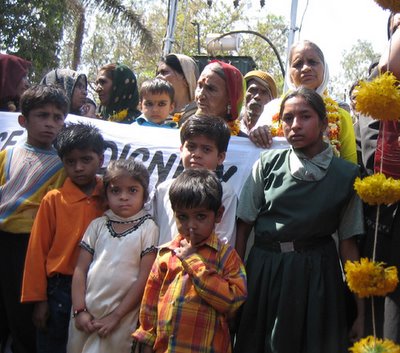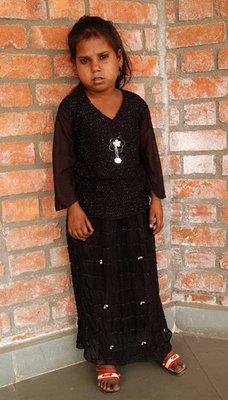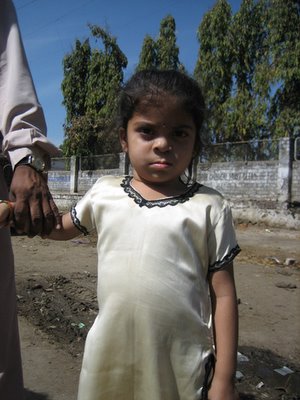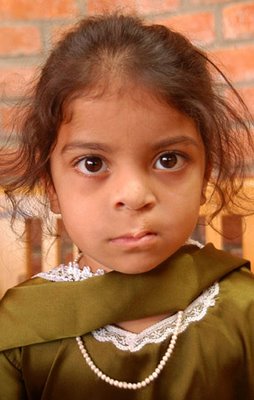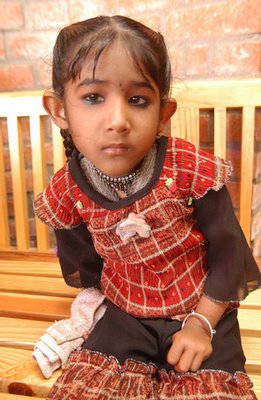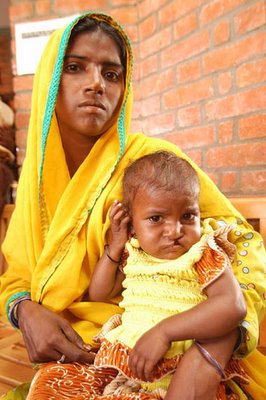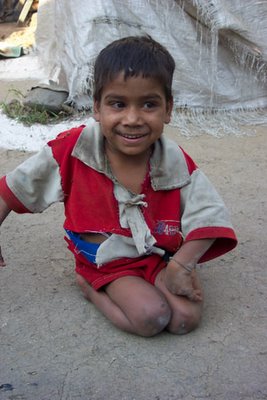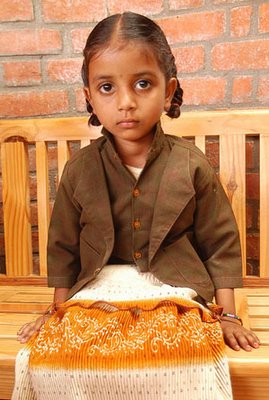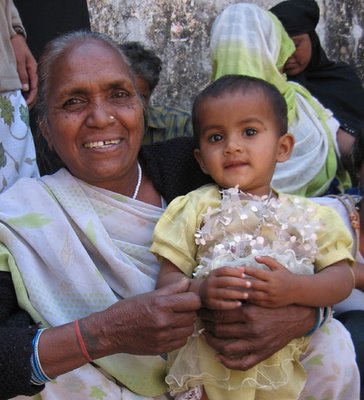27 February 2006
25 February 2006
ah, the global village
I got almost no sleep last night, staying up trying to do as much of this factsheet work as possible before getting out here. I feel pretty good though. Already have had a couple of roadside cups of chai. Sun is beating. More later. M.
bye bye
look ma, no hair

I shaved my head a couple of days ago, in preparation for more difficult travel. I kind of like the way it feels. I don't leave it exposed like this, usually -- too many mosquitos and too much sun. I've been wearing big bandana, which I'm also kind of liking. No, I'm not becoming some kind of monk or anything, silly rabbits. I just don't want lice or anything else. I want to keep my head cool and I won't be able to cut my hair for a while. I tried to get this done by a street stand guy, but he didn't really understand and I ended up having to shave it all by myself in the bathroom, unable to see what I was doing. It took more than two hours.
By the way, getting a haircut and/or shave on the street is quite an experience. I don't recommend it. Matthias told me it was great, but he must have gone somewhere else. Mine cost Rs. 25, a little over 50 cents, for a haircut and a total facial shave. I don't know how they did it because I just closed my eyes and silently chanted little ad hoc mantras about how the worst thing you could get from a dirty razor isn't all that bad and how I know he won't cut me the same way I know that in spite of Newtonian physics autorickshaw drivers won't crash, etc. I was covered in a dampish towel that looked and smelled as if it been used for at least that whole day without being changed or washed. I didn't see much, but I smelled it all. About 12 different things, ranging from absolutely awful (think dirty diaper) to perfumed dust - he covered my face in about three different things like that. I admired the guy's dexterity and craftsmanship. I did, however, wash thoroughly as soon as I got home.
24 February 2006
poem
paropakaaraaya phalanti vrikshhaah
paropakaaraaya vahanti nadyah
paropakaaraaya duhanti gaavah
paropakaaraarthamidam shariiramah
trees bear fruit for the good of all
rivers flow for the good of all
cows give milk for the good of all
may this body, too, be used for the good of all
23 February 2006
continuing on my dacoit tangent
Dreaded dacoit Gulbadan Pandey killed in Bhopal
PRESS TRUST OF INDIA
Bhopal, February 17, 2006
Dreaded dacoit Gulbadan Pandey and a member of his gang were shot dead in an encounter with police in Panna district of Madhya Pradesh on Friday, police said.
Acting on a tip-off, police personnel had surrounded the hideout of the dacoits in Kudar forest areas near Dharampur village since last night, according to Panna Superintendent of Police RK Marathe.
The dacoit gang opened fire at police who retaliated, killing the gang leader Gulbadan, who carried Rs 27,000 reward on his head and another dacoit Barelal Jadav this afternoon.
A rifle, a crude pistol and some cartridges were recovered from the site, police said adding that 14 criminal cases related to murder, dacoity, loot and abduction were pending against Gulbadan in Lanna and Satna districts and Danda in neighbouring Uttar Pradesh.
if you want to do something
http://www.studentsforbhopal.org/MarchToDelhi.htm
There a huge international campaign backing up the padyatra and this site makes it really easy to contribute in little ways like sending faxes to Indian consulates and things like that. The site is also very well laid out and has interesting graphics and coverage of the march.
22 February 2006
Maps and Space in India
Only a week and half before the march begins, we're trying to figure out the exact route and the distances between towns where we might sleep. This involves using maps. Maps hardly exist in India. It's just one more thing that someone like me might assume is a universal tool, only to find that in India it is all but completely absent. I might not have mentioned this before. I discovered it in Mumbai one night when I was trying to get to an internet station just a few hundred meters from where I was standing. I just couldn't figure out the route. I asked a cab driver and showed him a map (in my Lonely Planet book) of the exact place where we were. He didn't recognize it. Neither did any of the three or four other curious cab drivers who came over to have a look. After a few minutes of total confusion, the first guy asked why I didn't just go back to my hotel and go to bed.
No one uses maps or cardinal directions here, but everyone knows their way around perfectly, of course. It's a different way of thinking about a city, or a place at all. It's all based on what's near what. You can see it in the mailing addresses. The second lines of half the addresses in India begin with the word "NEAR", and many include no numbers at all.
So, the other day I tagged along with Rachna to some government offices in search of some maps of India so that we have some clue about how we're going to walk to Delhi. I should introduce Rachna because her name will come up a lot from now on. Rachna is the person here who focuses on the activist side of things around here. She's super cool. Absolutely formidable, in the best way. Apparently all the cops in Bhopal are terrified of her. This is Rachna:
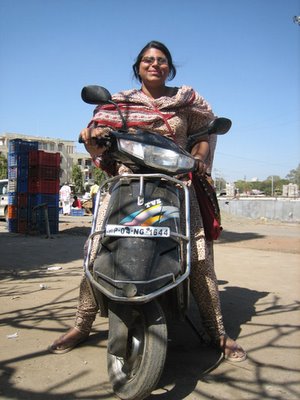 Anyway, I hopped on back of Rachna's motorscooter and we spent about half an hour zipping through Bhopal looking for the local branch office of the Geographical Survey of India. After climbing several flights of stairs in an old government building, we ended up around a table with three middle-aged men looking at some maps of Madhya Pradesh. They said they couldn't help us, though -- that we had to go to another government office [Survey of India] and talk to some other men whose particular specialty was sharing maps with the public. That wasn't too hard to find. A few minutes on the bike:
Anyway, I hopped on back of Rachna's motorscooter and we spent about half an hour zipping through Bhopal looking for the local branch office of the Geographical Survey of India. After climbing several flights of stairs in an old government building, we ended up around a table with three middle-aged men looking at some maps of Madhya Pradesh. They said they couldn't help us, though -- that we had to go to another government office [Survey of India] and talk to some other men whose particular specialty was sharing maps with the public. That wasn't too hard to find. A few minutes on the bike: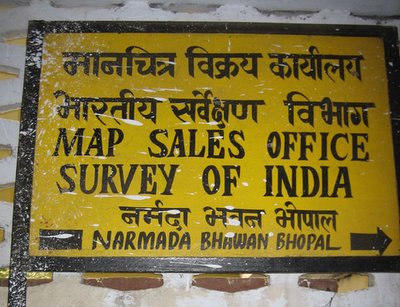 They were out to lunch when we got to the door. We sat down on the stoop and settled in for a wait. After about half an hour a couple of guys showed up but they couldn't open the office. Finally, almost an hour later, the manager arrived. We went in and sat down in chairs at his desk as if we were going to discuss a home loan or something. There were lots of maps on the wall. Almost all of them looked very old. 1970's fonts. Some of them sported fonts that haven't been widely used in the U.S. since the 30's and 40's. I would have believed anyone who told me these had been printed at about that time:
They were out to lunch when we got to the door. We sat down on the stoop and settled in for a wait. After about half an hour a couple of guys showed up but they couldn't open the office. Finally, almost an hour later, the manager arrived. We went in and sat down in chairs at his desk as if we were going to discuss a home loan or something. There were lots of maps on the wall. Almost all of them looked very old. 1970's fonts. Some of them sported fonts that haven't been widely used in the U.S. since the 30's and 40's. I would have believed anyone who told me these had been printed at about that time:
Rachna explained our purpose to the men behind the desk and asked for a map of Madhya Pradesh. They didn't have a map of Madhya Pradesh. (Yes, that's the state we are in.) Uttar Pradesh (the most densely populated state in India)? No. We ended up examining several other maps. They did have a map of Haryana, the small state to the north and west of Delhi. We will actually be passing through Haryana for a tiny bit, after leaving Madhya Pradesh, nicking a tip of Rajasthan and passing through a good chunk of Uttar Pradesh. This office also had a road map of all of India. Several hours after initially setting out into town, we ended up settling for that. It's not such a great map. The one I bought at a bookstore in New York has the same amount of detail and is a lot easier to read. So that's what we're going to use on the march -- something I picked up on the way home from work in Chelsea. [note: that is the map you see up on bhopal.net, too]
It's really hard for me to imagine how this all works. These maps show almost no detail -- only the big places. Everyone just knows how to get around locally without maps. And most people do not travel far here in India. In Mumbai, Jaipur, Udaipur, and here, I have met only a few people who have ever left any of those places in their whole lives. In Udaipur I was talking to this really nice middle-aged man who spoke English and he had never, ever been out of Udaipur. I felt so weird -- self-conscious, really -- having just zipped from Mumbai to Jaipur and over to Ranakpur to check out the temples and then back again to find myself having this conversation with this man who had never seen any of those places because, he said, it was simply too expensive for him.
Anyway, what I'm trying to convey in this post, I guess, is that the understanding of space, distance, directions, and travel here is fundamentally different than what I am used to, and it makes planning trips a very different sort of thing, too.
I really love the idea of setting out into this terrain full of people and places that no one really cares to map out in any detail -- to maybe have a chance to glimpse at what's right before my eyes instead of understanding it as part of a vast national grid combed over like a well-manicured lawn and perfectly scheduled to the last little detail. Back home in the U.S., it's generally wildest and untamed where there are the fewest people. What's so incredible to me about India is that it is how wild it is everywhere, even in the middle of a city like Mumbai, which has twice as many people as New York City and is just as dense or denser than NYC.

The map we finally settled on -- one I just happened to bring from New York.
p.s.
By the way, I asked Sathyu about this bandit country (aforementioned "dacoit gangs") and what they are or do. It seems they are traditionally gun-slinging horse riders who might have largely switched to motorcycles and/or jeeps. I asked him what, if any, plan we had for dealing with any encounters with these people and he just said, quite seriously, "we will ask for their support." I laughed out loud. If you knew Sathyu you would, too -- so typical of him.
bookmark this link
http://bhopal.net/delhi-march.html
Lots of good stuff, including a tracking map and link to blog. There is also some personal information about some of the padyatris. Each person going on the march filled out a questionnaire about everything from where they were the night of the gas to what their income is today. Their lives will blow your mind. A guy named Indra in the UK does the website -- I like his description below: "wild, snake-infested jungles and ravines haunted by dacoit gangs..." Sounds pretty cool, huh? I'm still working on the fact sheets. Going crazy. I hope to be out of here by tomorrow afternoon and tumbling down the road on a bus or motorbike looking for everybody. Right now they are in Pillukhedi, sharing info and making connections with people there who have been screwed over by Coca-Cola, which has taken most of their water and destroyed what's left. It's all about connecting the dots...
Blog with daily updates
Reports and pictures from the marchers. Follow their progress and see the towns and villages through which they pass. Meet the people they encounter. Share their adventure.
Using the map
Click on the route (left) to open a window with a large scale map. On here is shown in red how far the padyatris have progressed. Watch the red line lengthen.
Places along the route
The padyatris will be walking through some of India's remotest countryside, through wild snake infested jungles and ravines haunted by dacoit gangs. They will also be stopping in the famous cities of Gwalior, Agra and Mathura.
21 February 2006
Bhopal children
photos of the first day
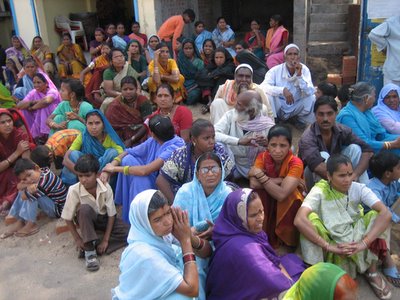 Waiting to begin, sitting across the street from the abandoned Union Carbide factory where it all began.
Waiting to begin, sitting across the street from the abandoned Union Carbide factory where it all began.
The inspiration for the padyatra (read my last post). All of these children of gas-exposed parents all have serious congenital problems. I don't know what to say. It was a very emotional thing for me and photographing them was difficult, but I really want people to see, and so do they, so here you are. There's so much I feel like saying or writing about it but none of it comes out right. It just hurts very, very badly to meet these children. I don't have other words now.
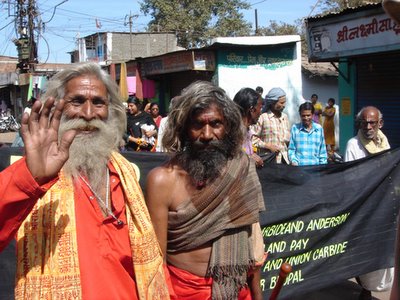 Happy, hopeful padyatris. Ganesh, the man on the left, is just a really radiant man. You can't help but be happy around him. His friend is completely barefoot. I don't know how he does it. 750 kilometers is long way to walk barefoot. This photo is not mine, by the way -- it was taken by a new volunteer named Jenny, from London.
Happy, hopeful padyatris. Ganesh, the man on the left, is just a really radiant man. You can't help but be happy around him. His friend is completely barefoot. I don't know how he does it. 750 kilometers is long way to walk barefoot. This photo is not mine, by the way -- it was taken by a new volunteer named Jenny, from London.Just yesterday alone really shoved me a lot deeper into speaking Hindi. There is almost no one on the march who speaks any English at all. I had to speak Hindi all afternoon. It's a mental workout. Harder than the walking. If I make it to Delhi I'll be thinking in Hindi.
20 February 2006
the long walk begins
I wish I could write more about things, but I've got too much to get done this morning. I will post some photos in a few hours. For now, here is the entry I just wrote for the first day of padyatra blog. That blog will be online at www.bhopal.net/march/ , I believe, but it has not been completely set up yet. I intend to post all the padyatra blog posts here, too, though. It will always be uploaded first and earliest to bhopal.net/march, though, so bookmark that page.
On Thursday or Friday I will find a bus that goes down the same road the group is walking down and hop out when I find them. I really can't wait to rejoin them. It's just an unbelievable group of people.
*********
Monday, 20 February 2006
Over 100 padyatris (marchers) gathered late this morning in front of
the abandoned Union Carbide factory to begin the long walk to Delhi.
Several gas and contamination affected parents brought a group of very
young children with birth defects and growth abnormalities to give the
padyatris their good wishes and to give the march energy and
inspiration for the long and difficult journey ahead. It was for
them, the children were told, that we are marching -- for their health
and their future.
The group began walking in the early afternoon, slowly moving down
several of Bhopal's most major thoroughfares before leaving the city.
Local and national media conducted many interviews and shot a lot of
footage. Police presence was high but non-threatening.
All the padyatris were extremely spirited and energetic. "Larenge!
Jeetenge!" the crowd shouted again and again -- "we will fight! we
will prevail!"
Several padyatris are currently ill, many are very old, most have
little with them but a pair of sandals and a few clothes, and every
one of them is embarking on the long walk at great personal risk and
sacrifice. The energy and excitement, however, was palpable. As soon
as we got out of the city we sat down by the side of the road and ate
some food that had been prepared this morning. Garlands of flowers
were passed around and everyone cheered. It was a happy, hopeful
moment at the beginning of a very hopeful journey.
*******************
addendum:
Everyone slept out under the open sky last night, at a school in
Gandhi Nagar, about 10 kilometers away from Bhopal. The group woke up
at about 4 a.m. to get a head start on the day and beat the sun, and
local people cooked breakfast for everyone. Today's walk will be much
longer -- it is 30 kilometers to Duraha, the next town on the route of
the padyatra.
17 February 2006
Padyatra
Today's press release:
Padyatris prepare to set out
Bhopal Gas Peedit Mahila Stationery Karmachari Sangh
Bhopal Gas Peedit Mahila Purush Sangharsh Morcha
Bhopal Group for Information and Action
Bhopal ki Aawaaz
February 17, 2006
Survivors of the Union Carbide disaster in Bhopal and people poisoned by ground water contamination from the pesticide factory that caused the world's worst industrial disaster on December 3, 1984 will start their Bhopal to New Delhi Padyatra (march on foot) on February 20, 2006.
Over 100 Padyatris will start walking "to the office of the Prime Minister at Raisina Hill, New Delhi" from the Union Carbide factory at 11 AM on Monday. They have already hand delivered the information on the 800 kilometers long march to the offices of the Prime Minister and the Chief Minister of Madhya Pradesh along with their six-point charter of demands.
The four survivors' organizations are seeking the Prime Minister's personal intervention in ensuring "justice and a life of dignity for the people poisoned by Union Carbide and its current owner Dow Chemical".
Their demands include immediate supply of safe water to the communities with ground water contamination, speedy prosecution of Union Carbide Corporation and its officials and blacklisting of Dow Chemical till it pays for environmental and health damages caused due to reckless dumping of hazardous wastes.
The organisations : Bhopal Gas Peedit Mahila Stationery Karmachari Sangh, Bhopal Gas Peedit Mahila Purush Sangharsh Morcha, Bhopal ki Aawaaz and Bhopal Group for Information and Action also demand the setting up of a "National Commission on Bhopal" for long term medical care, research and economic and social rehabilitation of the victims. They demand that the disaster in Bhopal must be made part of educational curricula and the creation of a memorial to the disaster with full participation of the victims.
A team of supporters in New Delhi will be communicating the demands of the Padyatris to the Director of the Bhopal cell in the Ministry of Chemicals on a daily basis. Supporters in other parts of the country will organize rallies and signature petitions to the Prime Minister. Members of the International Campaign for Justice in Bhopal will hold demonstrations at Indian embassies in USA and other countries in support of the campaign.
The ICJB's campaign web site www.bhopal.net is providing communication support to the marchers who will be updating blogs on a daily basis.
With their ages ranging from 19 to 70 years, the Padyatris are from gas affected areas such as Jai Prakash Nagar and Risaldar Colony as well as from areas that are affected by contamination of ground water such as Shiv Shakti Nagar and Blue Moon Colony. Their five week long journey will take them through Guna, Shivpuri, Gwalior, Dholpur Agra, Mathura, Ballabhgarh and other towns and villages in four states.
Walking between 25 and 35 kilometers every day, the Padyatris will depend on villagers and townspeople for food and shelter. They will exhibit posters, screen films and address public meetings along the way to create awareness about industrial pollution, corporate accountability and other issues of the Bhopal campaign. The four organizations today made an appeal to the people of Bhopal for financial and material support to the Padyatris and requested persons from the media to join in the march.
Rashida Bee, Champa Devi Shukla
Bhopal Gas Peedit Mahila Stationery Karmachari Sangh
+91 93031 32959
Syed M Irfan
Bhopal Gas Peedit Mahila Purush Sangharsh Morcha
+91 93290 26319
Shahid Noor
Bhopal ki Aawaaz
+91 98261 82226
Satinath Sarangi, Rachna Dhingra
Bhopal Group for Information & Action
+91 98261 67369
Contact :
House No. 12, Gali No. 2, Near Naseer Masjid,
Bag Umrao Dulha, Bhopal 462 010
For the latest information on the Bhopal to New Delhi Padyatra please bookmark www.bhopal.net/march/
rough week
Yes, I have a crushing amount of work. I've been working almost continuously from the time I wake up until past midnight, and there's just no way to get it all done. Once the sun sets there are so many mosquitoes and flies in my face it's hard to even type. And Bhopal's sole broadband internet service provider has decided to take its second 2-day vacation this week, making it very hard to do any research. It wouldn't be such a problem except that the march is leaving in less than 72 hours and they need this stuff, which is the equivalent of writing a 75-page, single-spaced paper on every aspect of the Bhopal disaster and its effects. Or at least collecting that much text and laying it out with photos and all that. I'm not anywhere near being done.
I have giardia. Positive diagnosis would involve taking several samples over a week or so and doing all kinds of tests in a lab, but who needs it. I have every symptom, a textbook example. Two weeks of diarrhea. Not just any diarrhea -- liquid steatorrhea. That's when you don't absorb lipids properly or at all and they all end up coming out in the toilet. I won't describe that in any more detail. I don't know why the parasite doesn't just eat it all, but I guess it only likes carbs and protein. There are a bunch of other symptoms, too, but I think I'll skip them for you. It should pass soon, and then there's a chance I will develop immunity.
I walked for a few miles tonight, down to the end of Hamidia Road and back, to try to reconnect to my situation and be able to get work done tonight. On my way back it was dark and I didn't get a single stare or "hello", which was just amazing for me. Almost like home. I am begging just to be ignored again, just for an hour, even. Is a compromise to be found anywhere? In New York, weeks could pass without a single person looking at my face, much less into my eyes. Here, though, it is impossible to hide if you are not Indian. And even if you are Indian, individual social/personal space is just a different game here. It basically doesn't exist. I'm realizing that it's really sort of an artificial concept to which we in places like New York falsely ascribe some sort of holy natural history.
Walking through Bhopal is very difficult by several things, one of which is the air. It's so thick with dust and smoke (more smoke than dust, by far) that tonight's walk, for instance, left me hoarse. I just cannot imagine being one of the many people who work along Hamidia or Berasia Roads all day, every day. It just hurts to think about -- that anyone would have to spend all their time breathing so much pollution. It's not like anything anywhere in the U.S., not even in the most polluted places. It's like being in a burning house. It hurts my eyes, it hurts my throat, it hurts my nostrils. They all burn. Everyone coughs. No amount of care and compensation could save your health if you had to spend your life in air like that. It's really sad. Cars and burning trash are really killing places like Bhopal. It's been the same everywhere I've seen, but worse in Bhopal. The smoke is suffocating. There is little to no municipal trash disposal system here so whatever doesn't get eaten by animals must be burned. Luckily, Sambhavna is set back far enough from Berasia Road that the air is much different here. And I spend almost all my time on the second floor, which gets more wind from places even farther away.
The weather is changing fast. The middle of the day now is extremely hot and I have to move very little and very slowly if I want to stay cool. The mosquitos are almost double what they were when I arrived. Lizards are everywhere. They are geckos, plump and delicate, a little bigger than the ones in Miami, and a very peaceful presence. I feel cooled just looking at them -- they are so still and their twisting bodies are so silent when they move. Last week an army of spiders emerged from some winter retreat. I don't like them as much as the geckos, but they can be pretty attractive, too. I respect their work. They sneak up on flies with more patience and stealth than a cat and jump surprising distances to kill them. I watched this today, the whole thing, in detail. I hate flies so much. The spiders worry me a little because they are absolutely everywhere and I'm sure it wouldn't be good to get bitten by one of these. But I have adopted a policy of respect and alliance, reciprocation of which is my aim. And the death of all flies. Go spiders. Katil makriyaa.
The mosquitoes have doubled in the time I've been here. Just going to the bathroom in the middle of the night means getting at least a dozen bites. We sleep under mosquito nets here, that's why I mention going to the bathroom. This is the place where the word mosquito is derived, actually. Our modern word mosquito comes from Spain, which got it from the Italian word 'moschetta,' which derives from the Latin word "musca," which comes from the Sanskrit word "mashka." India knows mosquitoes, and mosquitoes know India.
15 February 2006
Bhopal
"Bhopal isn’t only about charred lungs, poisoned kidneys and deformed foetuses. It’s also about corporate crime, multinational skullduggery, injustice, dirty deals, medical malpractice, corruption, callousness and contempt for the poor. Nothing else explains why the victims’ average compensation was just $500 — for a lifetime of misery . . . Yet the victims haven't given up. Their struggle for justice and dignity is one of the most valiant anywhere. They have unbelievable energy and hope . . . the fight has not ended. It won’t, so long as our collective conscience stirs." Outlook India 7 Oct 2002
13 February 2006
Traffic
 I have been studying traffic since the moment I arrived in India. It hasn't been until recently that I have grown accustomed to it enough to relax and begin noticing patterns. Traffic here is almost nothing like it is back in the U.S. It's not just that there are more vehicles, nor that they go faster or more recklessly, nor even that some of them are pulled by oxen. It's just a completely different way of interacting on the street. The intertwining movements of vehicles on the road here most closely resemble the tangled paths of pedestrians crossing each other in the main atrium of Grand Central Station. There are almost no traffic lights here. The last time I saw a traffic light was in Jaipur, and there were only a few there.
I have been studying traffic since the moment I arrived in India. It hasn't been until recently that I have grown accustomed to it enough to relax and begin noticing patterns. Traffic here is almost nothing like it is back in the U.S. It's not just that there are more vehicles, nor that they go faster or more recklessly, nor even that some of them are pulled by oxen. It's just a completely different way of interacting on the street. The intertwining movements of vehicles on the road here most closely resemble the tangled paths of pedestrians crossing each other in the main atrium of Grand Central Station. There are almost no traffic lights here. The last time I saw a traffic light was in Jaipur, and there were only a few there.Don't be fooled by the empty spaces in the few photos I recently posted -- Bhopal is a bustling city with intense, crowded traffic. It can be extremely difficult to cross the street (for me at least). Intersections here have absolutely no rules that I can figure out. Passing through them makes me feel like I'm in one of those medieval battles in Braveheart. The way it is done is that the driver just holds down the horn and charges forward into the middle, hoping others will believe that he or she is the most crazy and least likely to stop. Then you see how far you get before you have to slam on the brakes or swerve around the other players. It's pretty terrifying if you pay too much attention. Sometimes people hit each other lightly, and that's ok. As long as it's just a bump or nudge you can just keep on driving.
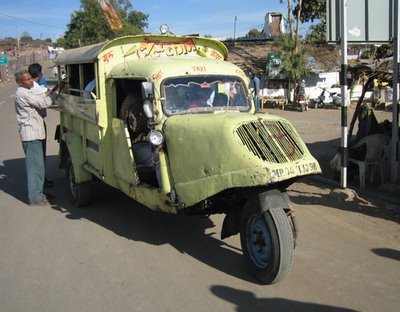 The elephantmobile, as I call it. I don't know, I just get an elephant feeling from it. Matthias and I took this one for about 11 km for a few cents each. It was my treat. It is from within this vehicle that the first shot above was taken. Over the course of that 11 km, about 20-25 people managed to ride in and/or on this thing simultaneously. Totally unbelievable.
The elephantmobile, as I call it. I don't know, I just get an elephant feeling from it. Matthias and I took this one for about 11 km for a few cents each. It was my treat. It is from within this vehicle that the first shot above was taken. Over the course of that 11 km, about 20-25 people managed to ride in and/or on this thing simultaneously. Totally unbelievable.Did I ever mention that in India one drives on the left side of the road? That is the idea, at least. It is fine to drive on the wrong side of the road for all kinds of reasons. You might, for instance, be looking for an address on the 'wrong' side of the road and know you're going to turn off at any moment. Or you might be going just a short distance and not want to go through the trouble of crossing all the traffic to get on the correct side of the road (because it certainly can be a lot of trouble when there are no traffic lights to stop the flow). Or you might be just trying to drift over to the right side of the road. Let's say you want to make what in the U.S. would be a "left turn" but here in India is a right turn -- a traffic crossing turn -- and there's just a ton of oncoming traffic and you can't make it over there. In a situation like that, you just drive straight into the oncoming traffic and swerve around, slowly working your way over until most of the vehicles around you are going in the same direction you are. I use the word "vehicles" because only a tiny minority of people on the road are in cars. Most are on motorcycles, and many are in auto-rickshaws, which have three wheels. And then there are buses and trucks. Cars are somewhere between all those I just listed and random things like mules, oxen, and people pushing huge, precariously balanced stacks of things on wobbling carts.
 Hindu adornments for good luck. Every vehicle has them. On Indian streets, luck is more important than gasoline.
Hindu adornments for good luck. Every vehicle has them. On Indian streets, luck is more important than gasoline.My favorite thing are the cows. Just picture it -- the traffic is such that crossing it on foot is a truly dangerous stunt. I frequently see huge cows, however, just wander into the middle of huge streets, completely oblivious and almost arrogant in their position as a holy animal, and just plop themselves down in the middle. Imagine this on Broadway. A big cow sitting on the pavement with every kind of vehicle missing its nose and tail by inches. No one honking -- everyone just swerves around it as it sits there for hours staring at the chaos swirling around it. No other animal dares to do this. I saw a bunch of goats get together and form an ad hoc street-crossing bloc that almost got obliterated halfway across. Only the cows can do it right -- they handle an Indian road like a beekeeper handles beehives. People do amazing things with motorcycles here. Just tonight I saw a family of six on one motorcycle. That is a normal motorcycle, too -- not some jumbo outfit. The father was driving with two kids stuffed in front of him. Then the mother and two more kids were carefully balanced behind him. Traffic here is made beautiful by Indian women on motorcycles. Most are in the second seat, behind a male driver. They usually sit sideways, and their often brightly colored clothing fluttering behind in the wind.
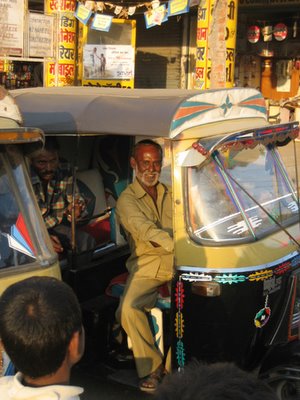 A proud autorickshaw driver. This guy absolutely insisted that his photo be taken by Maude, who had just taken a photo of another guy's car. Suddenly four or five different drivers ran from somewhere nearby and all jumped in front of their vehicles, clamoring to have their pictures taken. This guy would probably thrilled to know you are looking at his photo right now.
A proud autorickshaw driver. This guy absolutely insisted that his photo be taken by Maude, who had just taken a photo of another guy's car. Suddenly four or five different drivers ran from somewhere nearby and all jumped in front of their vehicles, clamoring to have their pictures taken. This guy would probably thrilled to know you are looking at his photo right now.Autorickshaws have been my main way of crossing the longer distances in Bhopal. Their engines are awful, though, and I'm not too happy about contributing to the dismal state of air in Bhopal by using this form of transportation. It's hard to imagine breathing hard enough to bike here, but I might try soon.
12 February 2006
Snow in NYC
It is getting very hot here. The way it works is that starting right about now it gets hotter and hotter and hotter here until it reaches about 45 degrees Celsius, or 115 degrees F. Those deadly days come in May and early June, I am told. Then the monsoon breaks and it rains every day. Everything greens up a lot and the now-empty pond here will fill up. The monsoon season is still hot but I am told it is very pleasant.
update
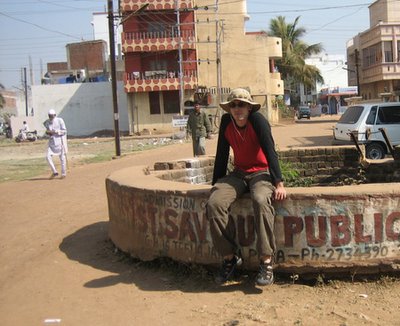
First, I just want to explain my internet/email situation. I feel really bad because there are a bunch of emails I haven't responded to after way too long. It's really hard to respond because the internet keeps cutting in and out. We didn't have it for a couple of consecutive days this week. The rest of the time I'd say I have access only one out of every fifteen times that I try. I absolutely do get, read, and savor all emails and I really appreciate them far more than the speed of my response would suggest. I post here more often than I write emails because at least then there will be some sign of life from me. Plus, it's easier to compose these posts offline and post them when I get a connection, whereas with email I like to see what people have written while I'm responding. It's hard to keep up here, too, though.
I've just realized tonight I have much more work than I thought. As I explained earlier, I am drafting up info-sheets for most of 33 demands to be issued daily during the march to the PM and central government of India. I somehow thought that they were just for distributing to passersby. Apparently, it is also these sheets that will be delivered to the government as the official statements of demands. So that puts a lot more pressure on me. I have an absolutely huge amount of work to do in writing, research, and battling with MS Word's always-wrong auto-formatting to get these all these sheets written, laid out, edited, printed, and ready for the march, which starts in exactly 9 days. I am also, of course, more than a little nervous about the march itself. More excited than nervous, though.
Anyway, for the next week I am going to be holed up here at Sambhavna working on this stuff from the moment I wake up until late at night every day. So I might not post as much. I have a bunch of offline writing I've done -- very general observations about being in India and stuff like that -- that I will post here in increments over the next week. I don't want to dump huge pages of text here all at once.
 (I took the photo above at the courthouse the other day, where several old Union Carbide executives on the Indian side of things were appearing. These women are gas victims, holding a noose.)
(I took the photo above at the courthouse the other day, where several old Union Carbide executives on the Indian side of things were appearing. These women are gas victims, holding a noose.)Once the march starts my posts will include more serious explorations of the the lives of the people surrounding me (poison-gas survivors and activists) and their stories. This is a deep place -- very special -- with a lot of heavy and incredibly inspiring stuff going on and I don't think my posts so far have really reflected that yet because I've been so busy trying to describe how different life is here in India in general and to paint the broader scene.
Life has been as crazy as ever. There's just an unbelievable amount to say about each part of each day that I can hardly decide what to write about. Right now I'm a little sick and very stressed, but it will be ok. I have some kind of cold and also diarrhea, which I think is unrelated.
Just wanted to mention bats. I have seen only a few bats in my life. There just haven't been many in the places I've lived. Right at sunset this evening I took a break to go stand outside on the terrace and breathe a little. The sky was completely filled with bats. Hundreds of bats in the dim light. They sort of tumble through the air. They were not flying in unison or anything, just twisting in all directions through the air like huge insects. I loved it so much I just stood and watched for a while.
08 February 2006
some photos
 This is the view from the front of Sambhava around sunrise. I still can't figure out how much of this haze here is smoke and how much is fog. It is pretty when the sun is low. This photo makes the scene look quiet, but don't be fooled. The first Muslim prayer chant thunders over Bafna Colony at 5 a.m. and loud Hindi music begins from various sources starting at about 7 a.m. We just got some visitors arriving from Spain last night and they were shocked this morning at how loud the music was, how late at night it ended, how early it came on, and how incongruously celebratory it seemed for place like this. I have already forgotten how this area looks or seems upon first arrival.
This is the view from the front of Sambhava around sunrise. I still can't figure out how much of this haze here is smoke and how much is fog. It is pretty when the sun is low. This photo makes the scene look quiet, but don't be fooled. The first Muslim prayer chant thunders over Bafna Colony at 5 a.m. and loud Hindi music begins from various sources starting at about 7 a.m. We just got some visitors arriving from Spain last night and they were shocked this morning at how loud the music was, how late at night it ended, how early it came on, and how incongruously celebratory it seemed for place like this. I have already forgotten how this area looks or seems upon first arrival.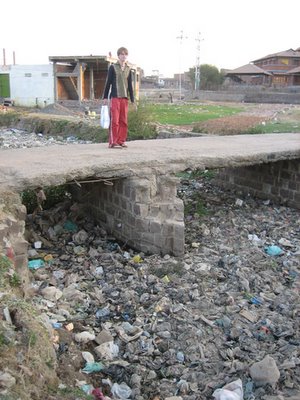 People have been asking to see the clinic. The clinic is visible above in the upper right corner of this photo -- brick building with sloping tile roofs. I took this on the way back to cook dinner after shopping for some ingredients on Berasia Rd with Maude and Matthias. This is Matthias here, standing on the bridge over the not-doing-so-well river that runs behind the clinic. Apparently it has more water than trash during the monsoon, but right now it is much more trash than water. I promise I will provide more close-up photos of the clinic at some point.
People have been asking to see the clinic. The clinic is visible above in the upper right corner of this photo -- brick building with sloping tile roofs. I took this on the way back to cook dinner after shopping for some ingredients on Berasia Rd with Maude and Matthias. This is Matthias here, standing on the bridge over the not-doing-so-well river that runs behind the clinic. Apparently it has more water than trash during the monsoon, but right now it is much more trash than water. I promise I will provide more close-up photos of the clinic at some point.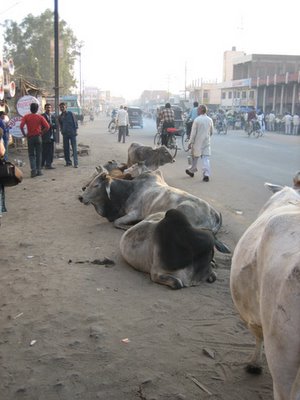 Some cows relax and contemplate the sand on Berasia Road, which is a five-minute walk from here and the closest place to buy vegetables and basic supplies. It's the main drag around this part of Bhopal.
Some cows relax and contemplate the sand on Berasia Road, which is a five-minute walk from here and the closest place to buy vegetables and basic supplies. It's the main drag around this part of Bhopal.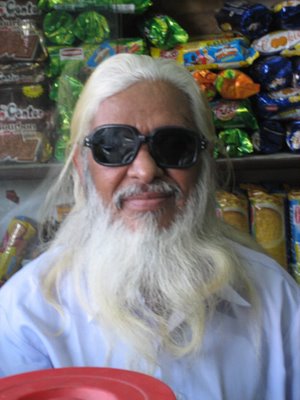 This man ran a small shop downtown. He seemed very pleased that I liked his beard and sunglasses combo so much (he ran his fingers through it, smiling) and happily posed for this photo.
This man ran a small shop downtown. He seemed very pleased that I liked his beard and sunglasses combo so much (he ran his fingers through it, smiling) and happily posed for this photo.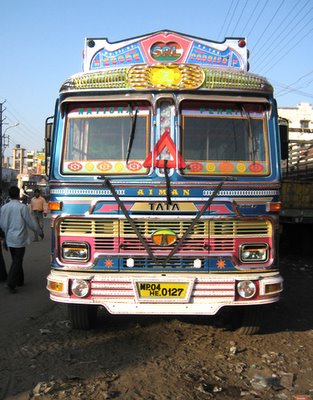 In India people decorate and adorn things as much as they can, whether with paint, foil, strings of lights, glitter, garlands of orange and white flowers (my favorite), or lots of other things. The buses here can be real works of art. Over the dashboard there are always garlands of flowers and most of them blast ethereal Hindi songs as they rattle down the road.
In India people decorate and adorn things as much as they can, whether with paint, foil, strings of lights, glitter, garlands of orange and white flowers (my favorite), or lots of other things. The buses here can be real works of art. Over the dashboard there are always garlands of flowers and most of them blast ethereal Hindi songs as they rattle down the road.
07 February 2006
"Highly absorbents super soft & Elegent" [sic]
 India can be a pretty heavy trip, so it's nice to have a roll of Sanam toilet paper to brighten my day. This little flourish of graphic design really lives up to Roy's assessment of India as the most random place on earth. "Sanam" means "darling" or "sweetie" in Hindi. I have no idea what they were thinking when they decided to present the word dripping with blood. We are left to wonder whether it is a reference to what our diarrhea might look like, or to some mayhem the lady on the left has recently unleashed. She is pretty terrifying. Look at her face up close. Did they find her in India?
India can be a pretty heavy trip, so it's nice to have a roll of Sanam toilet paper to brighten my day. This little flourish of graphic design really lives up to Roy's assessment of India as the most random place on earth. "Sanam" means "darling" or "sweetie" in Hindi. I have no idea what they were thinking when they decided to present the word dripping with blood. We are left to wonder whether it is a reference to what our diarrhea might look like, or to some mayhem the lady on the left has recently unleashed. She is pretty terrifying. Look at her face up close. Did they find her in India? 
And yes, that is a rocket ship back there, leaving the landscape behind it a sea of fire and smoke as it climbs past the exotic lavender flower and into the heavens, perhaps in search of more and better models for toilet paper labels. I don't know if they should mess with a good thing, though -- this little scene really evokes the kind of experiences I'm looking to get out of a roll of toilet paper. That's why I buy it.
03 February 2006
busy busy
I was afraid coming over here to Bhopal that I wouldn't be helpful enough, but as it turns out I am swamped with work. Apparently I will not only be writing on the march, but I will be the only photographer, too, which is a lot to handle. Maude is a professional photographer who was thinking about coming along, but she decided not to. Like I wrote earlier, the walk will last over a month, and there will be a different demand for each of the first 30-33 days. A two-sided printed info page for each demand has to be written up and laid out. Some of it is already done, but Sathyu wants me to finish the rest. So, I'm working on that now. And getting eaten alive by mosquitos as I type this. It's sunset right now. I better go move around. More later.
toilet talk
There are several kinds of toilets in India. The main one is the Indian-style toilet. This is a pear-shaped hole in the floor, framed by two treaded porcelain foot rests embedded in the floor. You squat (really the most natural position for letting it out, in light of the internal anatomy of the process) and then use the faucet and a cup of water to clean with your left hand. Whether you use this method or not, it is forbidden to do certain things with your left hand, like shake someone's hand. The second kind of toilet is the "Western" or "sit-down" toilet, which has been available as an option in most places I've been. A third kind of toilet is very strange and a bit of a mystery to most people I've talked to. It is the hybrid toilet. This is a Western-style, sit-down toilet with treaded foot pads sticking off the sides of the bowl like wings. It is hard to imagine anyone actually squatting on top of this thing, so high off the floor -- it seems like that would be dangerous, almost. And sitting on it is just as strange. I think everyone just avoids the hybrid toilet, which I had seen in photos before I ever came here, but they are nevertheless still manufactured and installed.
There are public urinals here, too -- something sorely needed in NYC. Usually it's just a unmarked nook behind a concrete wall. Sometimes rows of nooks. On the floor is just a little hole or a ridge in which some water trickles by. Sometimes it it's just a hole at the bottom of the floor so that the urine just runs out onto the ground, leaving privacy as the bathroom's only real purpose. The sewer systems I have seen here in Bhopal and elsewhere in India are open or semi-open. There are troughs or concrete ditches in which dirty water flows or trickles and meets up with other channels from other streets. Sometimes these are wide open and visible, but they are often covered by stepping-stone-style blocks of concrete. It's really hard to tell what's going on -- I see cracks, holes, and gaps around and there is liquid in motion underneath, and that's all I know right now. All the sewage and piping here at Sambhavna empties somewhere in the garden, but I'm not sure exactly where or how. We have to use only biodegradable soaps here. I have been showering with homemade lye-and-lipids soap with mint leaves mixed in it that my friend Erin made me in Brooklyn. I might figure out how to make my own for laundry if I can't find an alternative to borrowing Matthias's special biodegradable laundry detergent he brought all the way from Switzerland and will certainly not be available around here.
01 February 2006
First photos from Bhopal

This is a photo I took from the corner of Berasia Road and Union Carbide Road, a five minute walk from where I am. These are the people that live adjacent to the still piled-with-poison Union Carbide plant site and where drinking the water has serious effects on health. The majority of patients lined up here at Sambhavna have come because of the effects of that water.

This is one of the old drinking water pumps on Union Carbide Road, painted red (very late) as a warning that the water was toxic. They have even more recently been de-activated and better water is brought in by trucks and dumped in a few barrel-shaped plastic tanks that sit on the sidewalk.
The work I am doing here
For me it has been a very good introduction to Indian government bureaucracy and the variety of understandings around here of what the Bhopal situation was and is. The material is both technical (about ground water contamination and clean-up) and political (questions of culpability, responsibility, and human rights). A rough summary: The abandoned Union Carbide factory site has still not been cleaned up and the drinking water is poison. The people who live closest to it are extremely poor. Their neighborhoods are actually just encampments that are not officially or legally recognized by the local government, which does not provide normal municipal services or protection to anyone who lives there. Union Carbide says they settled long ago, of course (for peanuts), and they were bought by Dow, anyway. Dow is a brick wall, of course. They have absolutely no reputation to lose. India has a State-Federal system of government much like the U.S.'s. The state government of Madhya Pradesh says it is too poor to handle the problem on its own and only the Central (national) Government has the resources to pull Bhopal out of this mess. The Central Government says they weren't the ones on the corporate dole while the factory was operating. The hot potato game. Meanwhile Bhopal is still a poison pit after 21 years. (This is all just a super-quick stream-of-thought overview of what I've been hearing in all these audio-recordings.) The medical doctors won't say a word about all the dangerous chemicals people are drinking because they're just doctors and only know about whatever medical case is right before their eyes. The other scientists won't say a word about the fact that people are being poisoned because they are not doctors. One office even resorted to asking Matthias if he had a permit to be asking any of these questions in the first place -- that his tourist visa did not cover this sort of thing. I have been very impressed with his persistence and cool through it all.
So, that's what I've been doing so far. The rest of this week I will probably be doing a variety of other things, ranging from graphic design and writing stuff to helping arrange boulders around a new pond they just created downstairs. The library also needs a lot of work, too, I am told.
Then there is something really huge and important coming up. Starting on Feb. 20th, about two to three hundred gas survivors and people poisoned later by the water here are all going to march -- yes, walk -- from here to Delhi, stopping at certain other places victimized by transnational corporations and others through poison and pollution. This march was done only once before, 17 years ago. The chosen route is 900 kilometers (550 miles), and is expected to take a little over a month to complete. I am going to walk with them and document the journey in writing, journal-style, through interviews and my own observations. I have a lot of work to do before then -- the more educated and familiar I am before the march starts the more meaningful my coverage can and will be. So I am going to spending a lot of time reading and talking with gas-affected people who are planning to march. I also badly need to build up my Hindi vocabulary. The plan is that we will have a dial-up account and be able to use payphone jacks (they are like regular phones here) to dial in and upload text and images along the way. We can make it work somehow.
